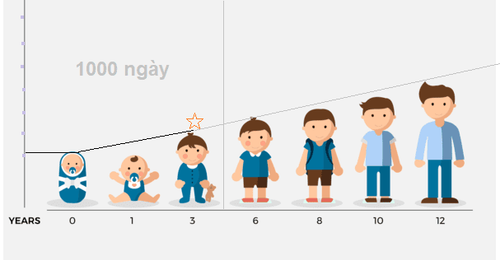The article is professionally consulted by Nguyen Minh Tuan, MA, MD, Pediatrician, Pediatrics – Neonatology Department, Vinmec Da Nang International General Hospital
The average height of young Vietnamese people has shown positive changes in recent years. Specifically, the average height of Vietnamese men has reached 168.1 cm, while that of women is 156.2 cm. Statistics show that the average height of Vietnamese people has increased by more than 3 cm compared to the results 10 years ago, helping Vietnam no longer rank among the "shortest in Southeast Asia."
1. The Average Height Increase of Vietnamese People Over the Past 10 Years
The Ministry of Health recently published survey results conducted by the General Statistics Office and the National Institute of Nutrition during 2019–2020. According to the data, the average height of Vietnamese young men is 168.1 cm, while that of women is 156.2 cm. Urban children are, on average, 2 cm taller than rural children, particularly those in poor rural areas, disaster-prone regions, and mountainous areas.
Compared to 10 years ago, the average height of young men has increased by 3.7 cm, while young women have grown taller by 2.6 cm. Notably, the height of Vietnamese people born after 2000 is significantly better than previous generations, with the growth rate nearly doubling compared to the previous decade.
Based on these new height statistics, nutrition experts have assessed that Vietnamese youth are not only "escaping short stature" but are now ranked among the top 4 tallest nations in Southeast Asia. The average height of Vietnamese men and women is comparable to that of Malaysia, with only Singapore and Thailand being taller. When comparing the height of Vietnamese people to global standards, the Ministry of Health has noted that the growth achieved by Vietnamese youth from 1990 to 2020 is equivalent to Japan’s golden period of height increase (1955–1995) and the height growth observed in European countries in the late 19th and early 20th centuries. To narrow the height gap with the tallest Asian nations (such as South Korea), Vietnam must maintain this growth rate in the coming decades.
2. Efforts to Improve the Height of Vietnamese People
The positive results in this Vietnamese height survey are attributed to interventions over the past 20 years. Therefore, it is not surprising that the average height of Vietnamese people has increased by 2.6–3.7 cm among young women and men compared to 10 years ago in this survey.
In recent decades, Vietnam has conducted height measurements every 10 years. The National Institute of Nutrition stated that this survey was conducted in late 2019 and early 2020, with a sample size of 22,000 individuals living across all regions of Vietnam. Specifically, measurements were taken for individuals under 25 years old to examine height. This was the largest survey ever conducted, with assistance and sample validation provided by experts from the U.S. Centers for Disease Control and Prevention (CDC).
The participants in this survey were primarily born in the 2000s, a period when Vietnam began nutritional interventions to support growth during the first 1,000 days of life, followed by school nutrition programs, deworming initiatives, and vitamin supplementation. In contrast, the previous survey included individuals born before 1990, a time when Vietnam had limited nutritional interventions and faced economic challenges.
The 2020 survey also revealed that the stunting rate among Vietnamese children under 5 years old was 19.6%, marking the first time this figure fell below 20%. As a result, Vietnam is classified as a country with a low stunting rate according to the WHO classification in 1997.

3. Nutritional Factors Affecting the Height of Vietnamese People
Compared to 10 years ago, the average energy intake in the diet of Vietnamese people has reached 2,023 kcal per person per day, a slight increase from 1,925 kcal per person per day in 2010. Additionally, Vietnamese people consume more vegetables and fruits, with the average daily vegetable intake increasing from 190.4 g per person in 2010 to 231 g. ruit consumption, which was only 60.9 g per person per day in 2010, has now risen to 140.7 g. However, compared to the nutritional recommendations for adults, this level of consumption only meets 66–77% of the recommended intake.
Furthermore, the consumption of meat has increased among Vietnamese people. Currently, the average person consumes 136.4 g of meat daily, compared to 84 g in 2010. Urban residents eat the most meat, averaging 155.3 g per person per day.
Since the first three years of life are crucial for height development, breastfeeding rates must also be considered. Over the past decade, the percentage of families practicing exclusive breastfeeding during the first six months has improved significantly from 19.6% to over 45%. This rate is also higher in urban areas compared to other regions.
Moreover, public awareness and proper practices regarding food safety and height development have increased. Approximately 36% of people have good knowledge, nearly 56% are at an average level, and only about 9% show poor understanding.
The findings from this survey on the height and nutrition of Vietnamese people will assist experts in developing new national strategies. For parents, it is essential to focus on nutrition during the first 1,000 days of life—a critical period during which children can grow 10–14 cm per year if properly cared for. Women should begin eating a balanced diet and taking micronutrient supplements as soon as they plan to conceive.
Visit the Vinmec International General Hospital website to access more health, nutrition, and wellness information to safeguard the health of yourself and your family.
Note: This article is part of the Vinmec International General Hospital System's Awareness Program on Growth Retardation, with the support of Novo Nordisk
To arrange an appointment, please call HOTLINE or make your reservation directly HERE. You may also download the MyVinmec app to schedule appointments faster and manage your reservations more conveniently.









